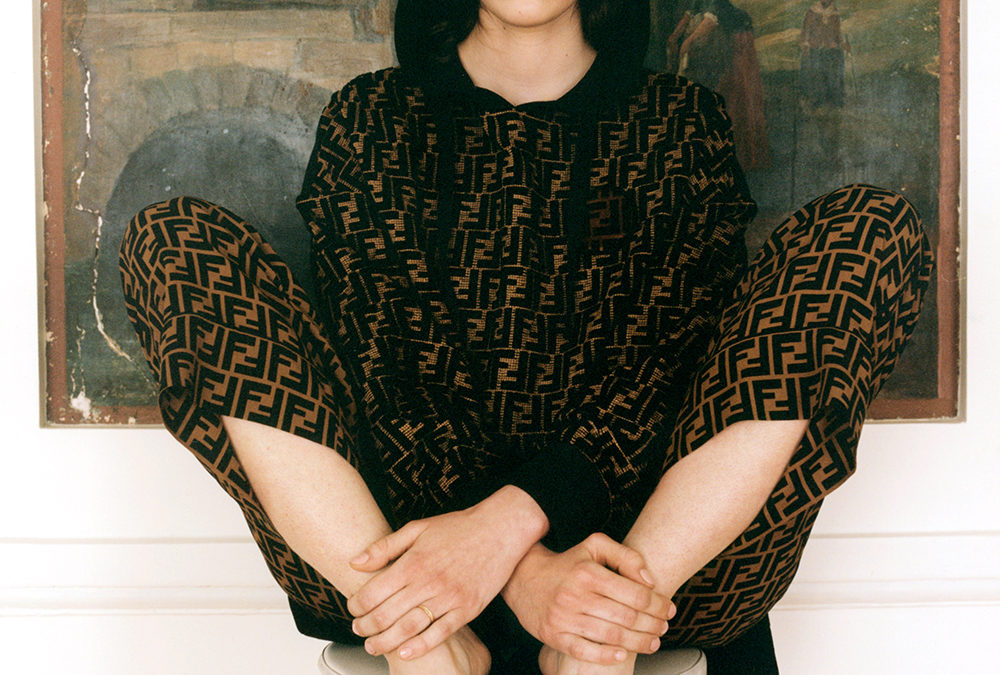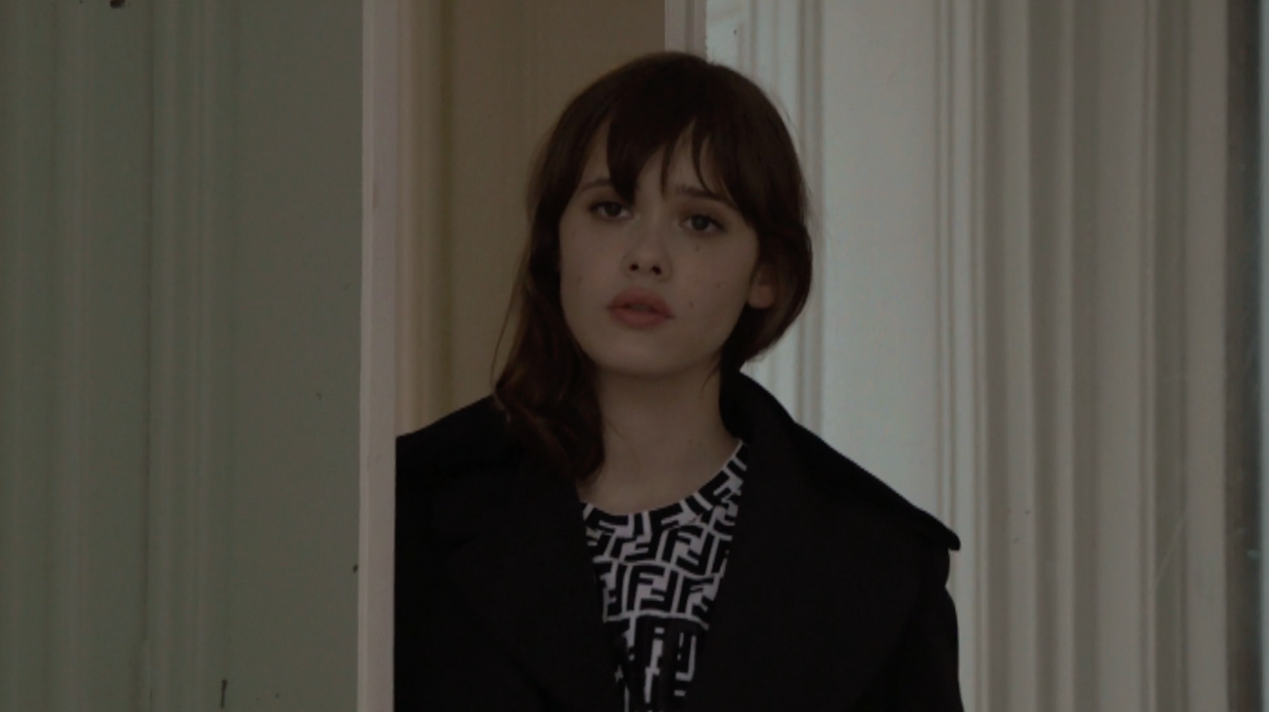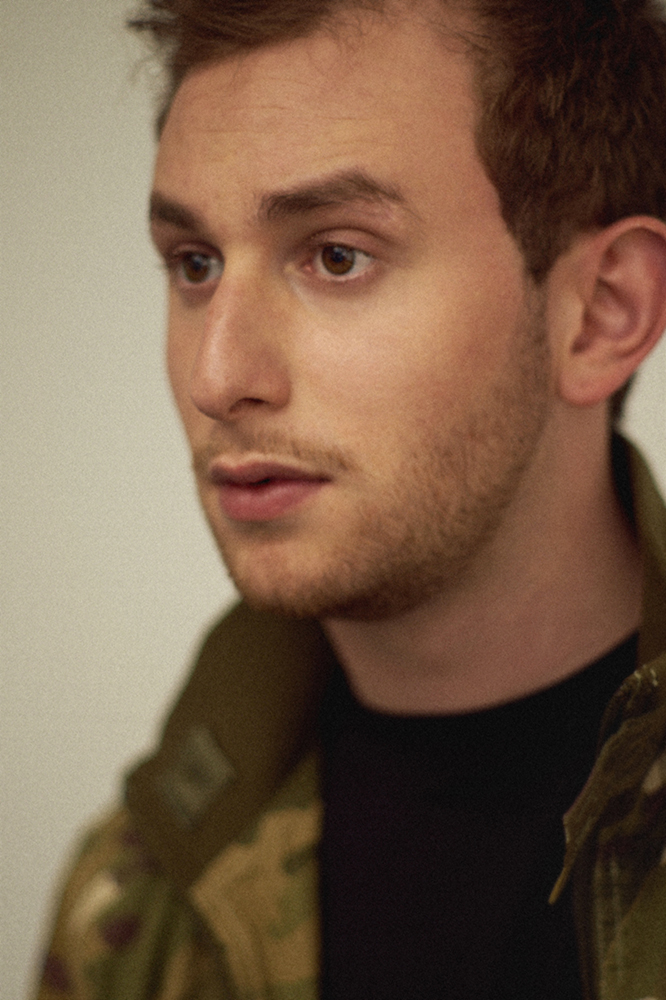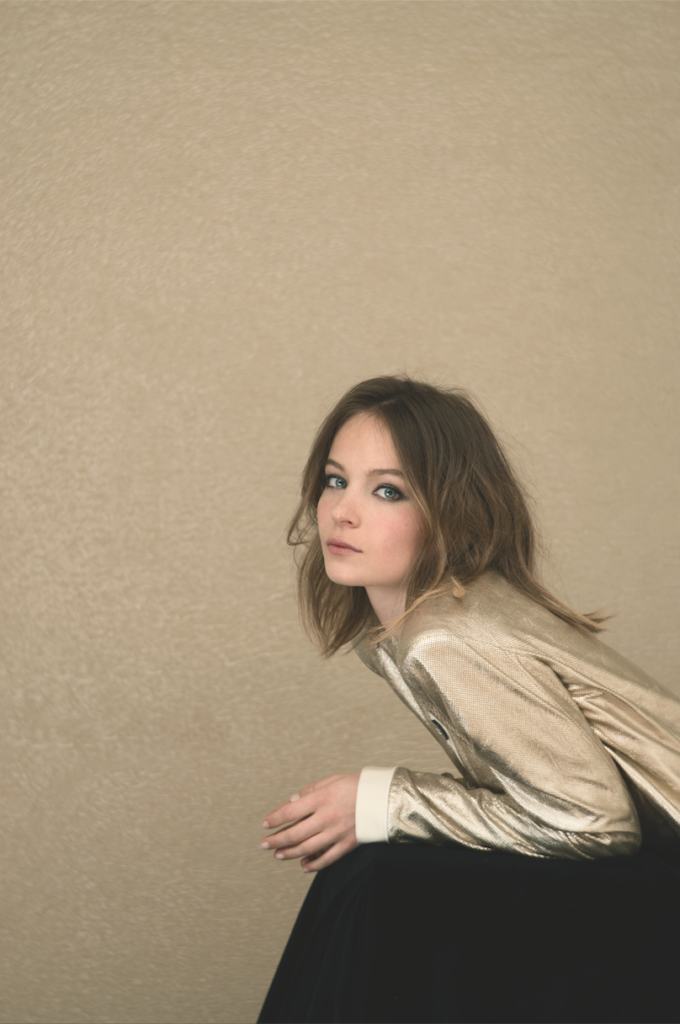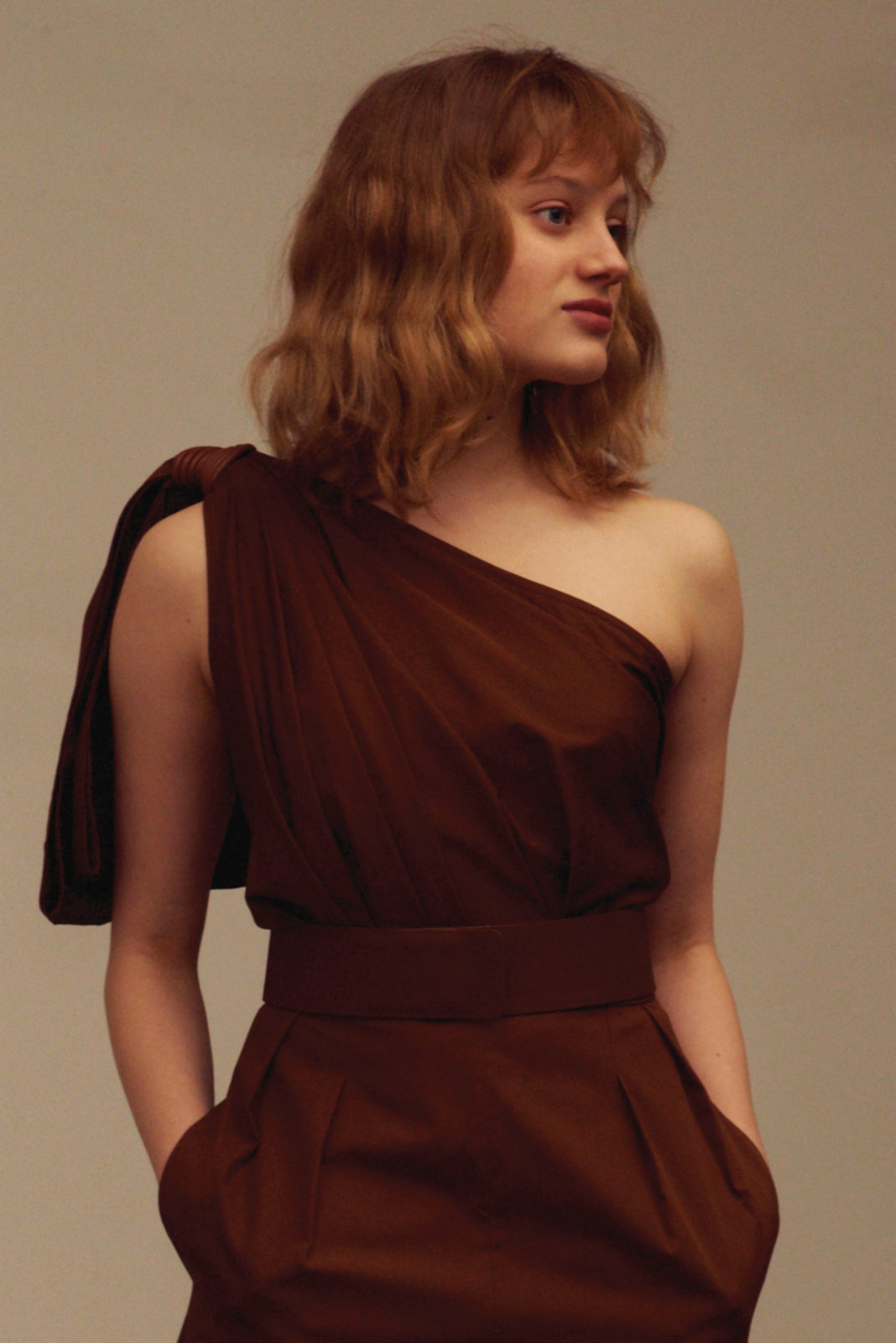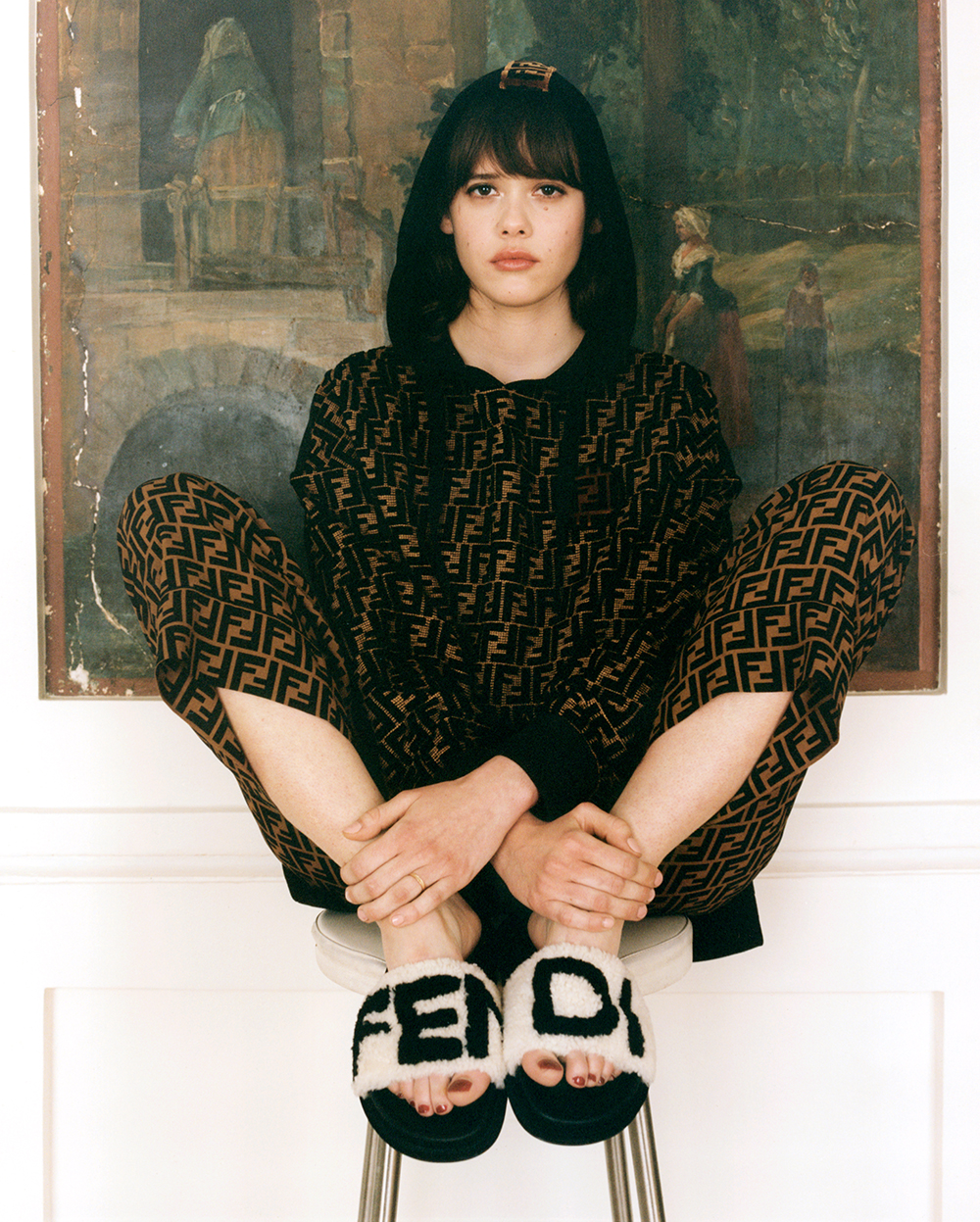
Fendi - FF cotton hooded sweatshirt, Wide silk trousers with FF pattern and Sandals with lined skin strap
A MEETING WITH MATHILDE WARNIER
By Alice Butterlin
On the occasion of the release of The Serpent on Netflix, rediscover our interview with French actress Mathilde Warnier from our issue #84.
Originally discovered on the small screen, Mathilde Warnier always dreamed of making it in the movies. A film buff ever since she was a teen, she wasted no time getting noticed on set in a pair of small but enchanting roles: first in 2013 in Antoine Blossier’s The Grad Job, then in Emmanuel Mouret’s Caprice. At the same time, she also stars in the TV series A Very Secret Service, whose second season is set to premiere in May. Written by two screenwriters from OSS 117, the series parodies the secret services found in spy movies from the 1960s. With her doll-like face and mischievous expression, it was Bertrand Mandico’s The Wild Boys that revealed all her acting talent. In this strange and beautiful film, she plays a teenage boy grappling with adolescent urges who gradually transforms into a woman. Her performance is remarkable, while this foray into the demanding and disturbing world of underground cinema fits her like a glove.
Today, she is photographed in Fendi to mark the launch of a capsule collection that explores and revisits the fashion house’s iconic logo, created by Karl Lagerfeld in 1965. Shedding a portion of its original rectangular form, the logo now fits snugly into a square, while a combination of black and white hues joins Fendi’s more familiar palette of tobacco and black. Hard to believe that Karl Lagerfeld has sat at the helm of Fendi for over fifty-three years now. His minimalist logo, consisting of two Fs for “Fun Furs,” is just as relevant as ever at a time when branded acronyms have conquered nearly every corner of the planet. For this capsule, the challenge consisted in translating the brand’s Italian sophistication into relaxed pieces like parkas, bombers, and sweats. Accessories become a focal point of the capsule: graphic leather bags get covered in the 3D velvet monogram, sandals undergo a furry metamorphosis, and sneakers sport a futuristic white sole. But the collection would not be complete without a fur pompom key charm – the ultimate Fendi accessory.
You are currently in South Africa. Are you traveling for business or pleasure?
I’m here to shoot a British television series. I won’t say anymore. I’ll let you find out on your own. I was in Cape Town in January and now I’m in Durban, on the other coast. They’re two completely different places, but both very charming. My hotel is right on the beach and it’s so beautiful!
How did you discover the film industry?
My twin sister did a film major with Thierry Méranger, who is one of the editors at Cahiers du Cinéma. I did a lot of drawing, and I love visual art. But I never had a thing for film. It was my sister who sparked my interest and introduced me to her classmates. That’s when I decided to pursue it and do the film major at my high school. My professor was brilliant. He taught us how to write and helped us build a vast knowledge of film. We met a lot of directors and people from the industry through our film club. The same professor continued to help me out into my twenties and suggested I become a producer. So I got a BTS degree in production and that’s when I got discovered while working on a TV set. I had never given much thought to becoming an actor. I have four sisters including one twin. Wanting to act meant wanting to be seen, and I had to think about what that would mean in relation to my sisters. So out of humility, I never considered acting as a career. But since I always wanted to tell stories – and I’m a terrible writer – my only option was to live them.
How did your sisters respond when you told them you wanted to act?
They thought it was weird. I don’t think they really pictured me as an actor, but it makes them happy because it makes me happy.
What was your first experience in film?
I appeared in a film called The Grad Job, which came out in 2013. It was my first casting and I learned a lot from that movie. I had never acted outside of high school. I skipped class to act in a movie and all my friends roasted me when they saw the video. (laughs) They made it into a joke and let me know I would never be able to act in anything. But now I’m an actor, so it’s just a funny little story to look back on. The Grad Job was a teen movie, it was cool working with other young people on my first film. It’s not really my favorite kind of movie, but I don’t regret doing it. Then I had a small part in Caprice with Anais Demoustier and Laurent Stocker. I also had a part in A Very Secret Service, whose second season premieres soon. It runs on Arte and was written by the writers of OSS 117. I’m so happy to be a part of this project.
Can you tell me about your role in the upcoming film The Wild Boys, directed by Bertrand Mandico?
We filmed it two years ago now. Bertrand is an incredible visual artist, the kind you rarely see today. When I was paging through the script I knew I absolutely needed to get the part. It’s the kind of cinema I love. When I was in high school, I loved Guy Maddin’s films, they really spoke to me. I thought it was wild to make movies with so much fantasy. He’s one of the immediate forebears of Bertrand Mandico’s cinema. The Saddest Music in the World is a brilliant film with Isabella Rossellini in a completely insane role. But to get back to The Wild Boys, I did a lot of preparatory work before the casting. Bertrand and I got along so well right from the start. I wasn’t familiar with his work, but he sent us all his movies. He decided to hire me because when he was going through the pictures of all the actresses in wigs, his son thought I was a boy his age. (laughs)
What did you think when you watched all his films before the casting?
I was immediately reminded of Guy Maddin, Buñuel, and the kind of cinema that’s big with fanzines. (laughs) There is something underground and DIY about his movies. Bertrand is someone who chooses every detail with care, including the set decoration and music. You have to remember that he started as an illustrator. He’s an incredible person. I’m so proud I was able to work with him.
He does the set decoration?
In part. Everyone gets swept up in his vision. Of course we also have the director of photography and decorators. That part was all pretty complicated on our film, because there were a lot of surprises on the island of Reunion. But it all comes out of Bertrand’s mind, in any case. All the set decorations were based on his sketches. We were working inside his imagination.
Do you have any exciting memories from the shoot in Reunion?
I remember the camaraderie most of all. It’s a buddy film after all. (laughs) I made real friends there and that doesn’t always happen on film sets. We formed strong bonds there. The landscape was breathtaking, but my strongest memories are my friends’ smiling faces and how kind everyone was.
Was it a physically demanding experience on set?
There were a few directing challenges, but for us as actresses, we were in a constant state of healthy rivalry, which means we told a lot of dirty jokes and laughed a lot. We shot for a month in Reunion and then in the studio for the boat scenes.
How did you manage to transform into a boy for the film?
That was my dream as an actress. In my first interviews, whenever I was asked about my dream role, I would tell people I wanted to play a boy. Little did I know that it would come true one day. The universe heard my wish and granted it. (laughs) It’s important to question our notions of gender, to realize there isn’t much that separates men and women. I don’t think we’re very different when we’re young. Violence is the same among both sexes. The film talks about that, too. Camaraderie can bring along copying, perversion, and all sorts of things we experience in our teen years. It’s also a film about transformation, entering adulthood, desire, and puberty. As a woman, it can feel strange when your breasts grow. When my breasts started to grow, I did everything I could to hold them in. It’s hard to accept becoming a woman.
Did you look to any male muses for inspiration?
I looked for the boy within myself first. He’s not so hard to find. I spent a lot of time observing my friends, too. I asked them a lot of questions, about being a teenager, about desire, even about penetration. We don’t know what it’s like to have a sensitive member that feels good when it enters another person. It’s a bizarre concept for us. The boy I played wanted pleasure and to satisfy his desires. I also spent time watching boys in the subway, their center of gravity, how they move in space. In the end, that didn’t really help me because I still run like a girl in the movie. (laughs)
Everything is mixed up from the start, and the character’s gender is never clearly defined. The viewer is constantly left in doubt. Did Bertrand give you any specific indications about how to portray a boy?
Yes, he gave each of us a physical reference. I got Mick Jagger and Anaël Skok got Sid Vicious, for example. But Bertrand mostly just trusted us. In his casting he wanted to have different colors, while staying true to each actress’s personality. He didn’t want to fall back on a simple kind of cross-dressing. Many people were surprised and asked him about his choice. I think he thought it would make the transition easier. I don’t recall ever seeing a movie where a man plays a real woman.
Going beyond the aesthetic level, it’s the kind of film that tempts us to hunt for hidden meanings and pick apart all its symbolism. Is it a film that is remarkable solely for its strange beauty or does it raise real issues?
Since I’m not the director, it’s hard for me to talk about the subtext. I don’t want to butcher the meaning. But I can give you my own personal interpretation. I think it’s a kind of joke. We think that by turning into girls, boys will become nicer, but not at all, they will have all the same violence. At the premieres for the film, people were shocked by the last line: “Remember girls: Never be vulgar.” For Bertrand, it’s profound irony. We were all wondering about this passage. I think Bertrand probably likes this little misunderstanding. He probably enjoys aggravating people, in a certain way. He’s a punk after all. (laughs) He’s a total anti-conformist.
Do you feel at home in experimental or collage films that are rooted in specific references?
Yes, it’s the kind of cinema that I liked from a very young age. I have some absolutely lovely things coming out soon, not necessarily in the same genre, but that are also up my alley. In any case, the kind of movies Mandico makes are the kind I want to watch. Even if I wasn’t in the movie, I would go see it in the theater. It was screened at L’Étrange Festival, an event I love going to. They show a lot of Japanese films and a bunch of absolutely sick stuff. It’s great.
I can’t wait to see what you have in store for us with your upcoming projects.
I just finished a spectacular film called Curiosa directed by Lou Jeunet. It’s about the nineteenth-century writer Pierre Louÿs and the poet Marie de Régnier. Pierre Louÿs collected some of the first erotic photographs. It stars Camélia Jordana, Noémie Merlant, and Niels Scheider. Next, I’m going to do an American movie. I have a lot of roles in English coming up, which is amazing. I like it, I think it’s fun. How you act changes when you switch languages. I’ve got a thick accent, but I speak fluently. Plus I do French roles with an accent, too. I also shot a pilot for a comedy directed by Samuel Abrahams for YouTube where I play a young art student in London.
Do you still model on the side?
I’m not from a very wealthy family, so I had to take care of myself from very early on. I have my father to thank for teaching me responsibility from an early age. I modeled just to pay the rent. It’s as simple as that. (laughs) I don’t do it at all anymore.
Did it give you a sense of body awareness in front of the camera?
Modeling and acting are very different. I’m not sure if the best models would make good actresses. Modeling didn’t make me any more comfortable with my body. Since I’m not super skinny or very tall, modeling just gave me a bunch of complexes more than anything else. My boyfriend is a director but also does a lot of photography and I like posing for him. But it’s something I do just for fun, with my friends. Modeling all the time seems like a sad career. When you’re an ordinary girl who’s not too comfortable in her skin, and you’re compared with all these bodies that look like aliens, it can only do more harm than good. I don’t always know why I was picked over other girls. The worst part was the atmosphere in the castings. It’s a never-ending critique of your physique. That said, I don’t regret that period of my life because I met a lot of wonderful people.
This year is the twentieth anniversary of Crash and fifty years since May 1968. What does revolution mean for you, both in film and in society?
I think Bertrand is bringing a breath of fresh air to film. It’s been a long time since we’ve seen a film with so much freedom, and that’s certainly a revolution. I hope it helps more unconventional filmmakers in their careers. The production company Ecce Films is amazing, too. It helps a lot of original work get made. But beyond that, what is revolution? Is it wanting to be free? We all want to break with the disgusting stuff that has come before us, especially in politics. Should we start the revolution like in the past, with the same tools? I’m not so sure about that. In any case, I do think about how to start a new dynamic. Activism today is not like it was in the past, that much is clear. But how should we do it? Does being an activist mean believing in a utopia that we want to see in real life? Did the utopias of the past have a positive impact on society? As far as politics go, I’m lost. I don’t connect with anything and I don’t think I’m the only one. I loved the energy of Nuit Debout, but what did it change? All these issues worry me. It was nice to see the sort of feminist revolution recently, with the “silent majority” expressing itself. Since we’re still in the thick of things, it’s hard to step back and talk objectively about it. I’m sure there will be some interesting theories about it in the future, but what I see a mostly positive energy today, despite some gaffes and missteps. I don’t like the idea of fighting, it rubs me the wrong way. But at the same time, it can be a necessary thing. The Internet age has helped advance free speech, but it has also brought along some negative effects.
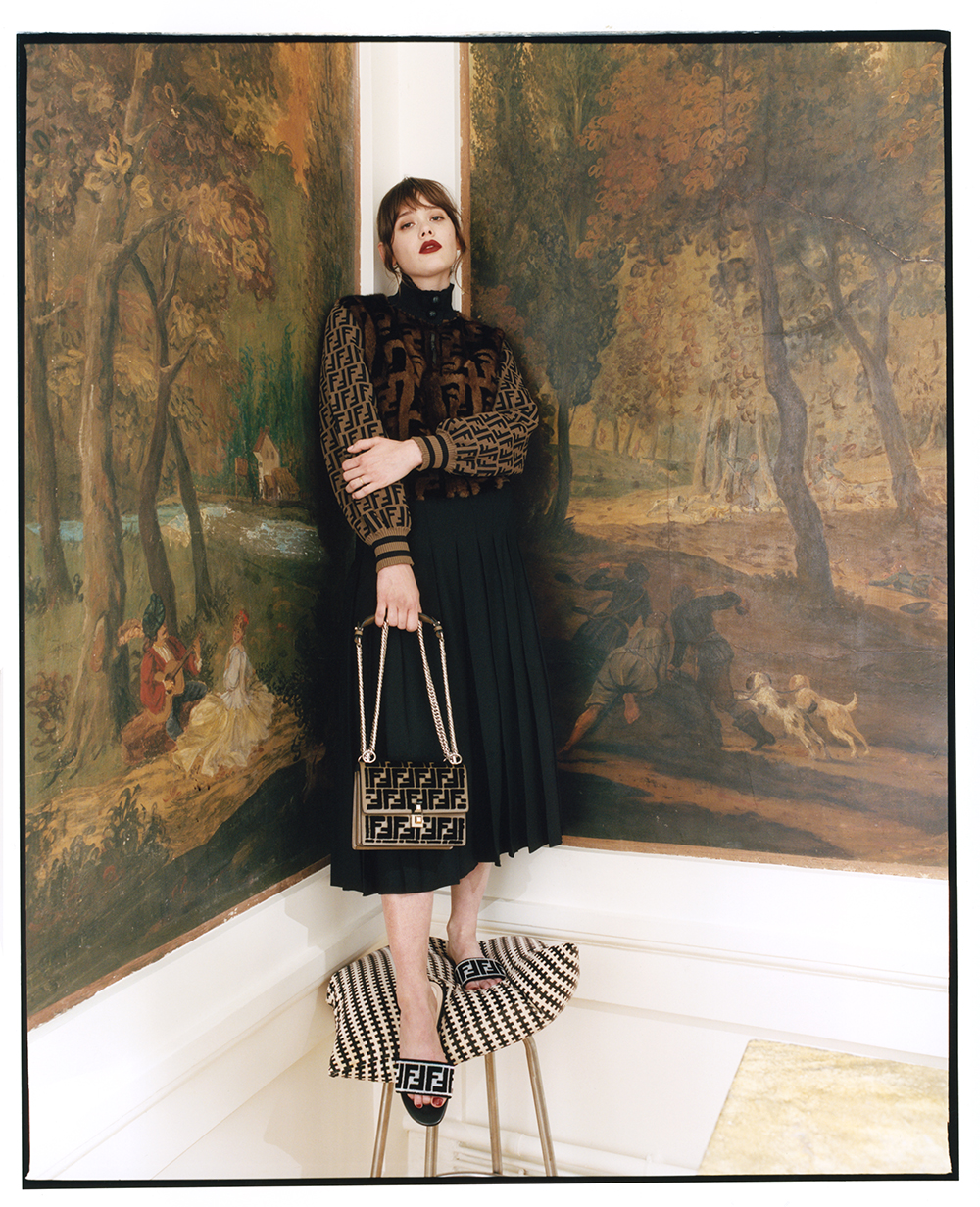
Fendi – Mink fur bomber jacket printed pattern FF, micromesh sleeves, Black pleated skirt, Sandals with velvet FF band and « Kan I » bag in calfskin and velvet FF embroidery
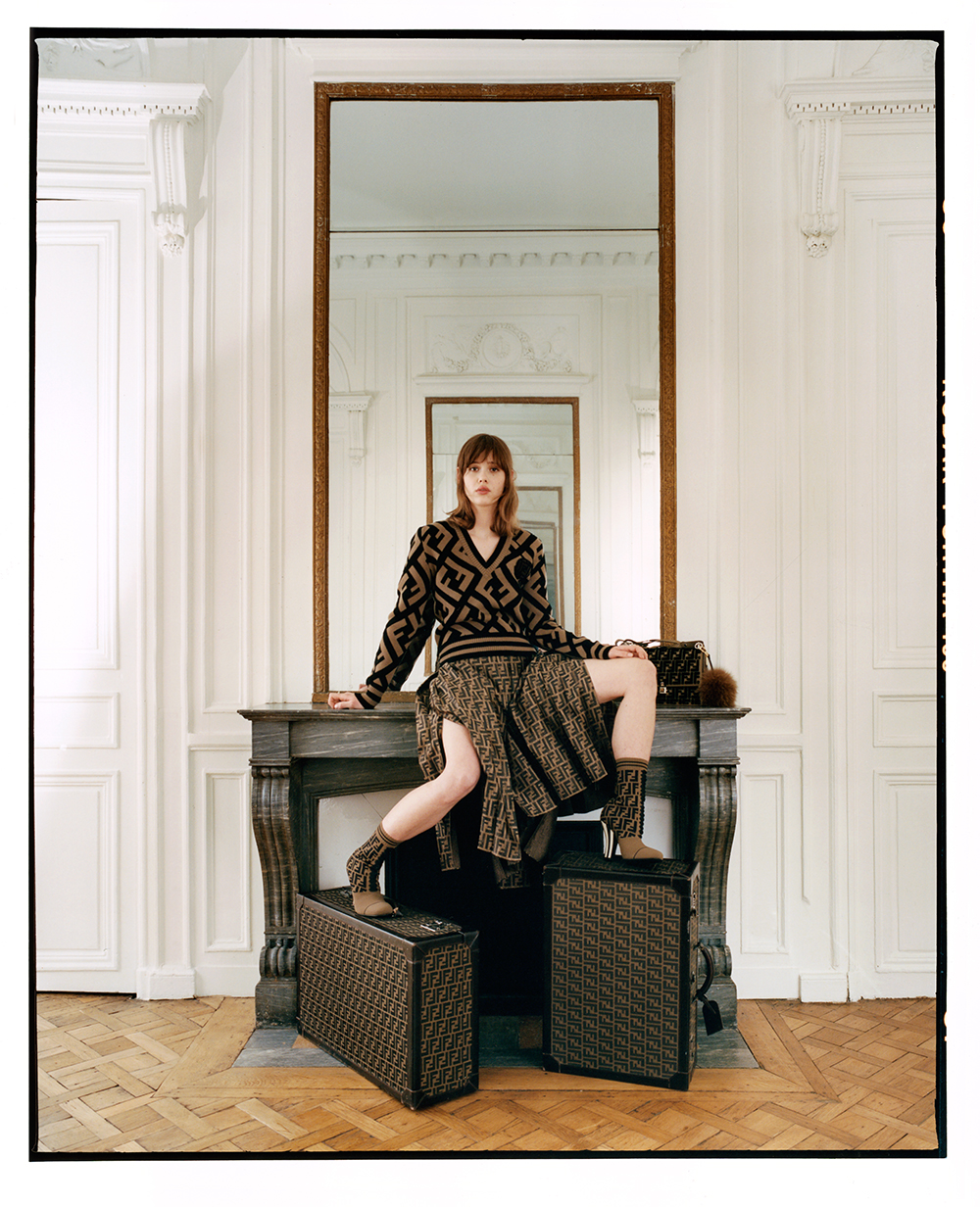
Fendi – Mohair sweater, Silk split skirt with FF pattern, Micro-mesh boots FF, Leather trunk and fabric with vintage FF pattern

Fendi – Mink fur hat pattern FF, FF velvet pattern bombers, Black pants and Micromesh basket with FF pattern
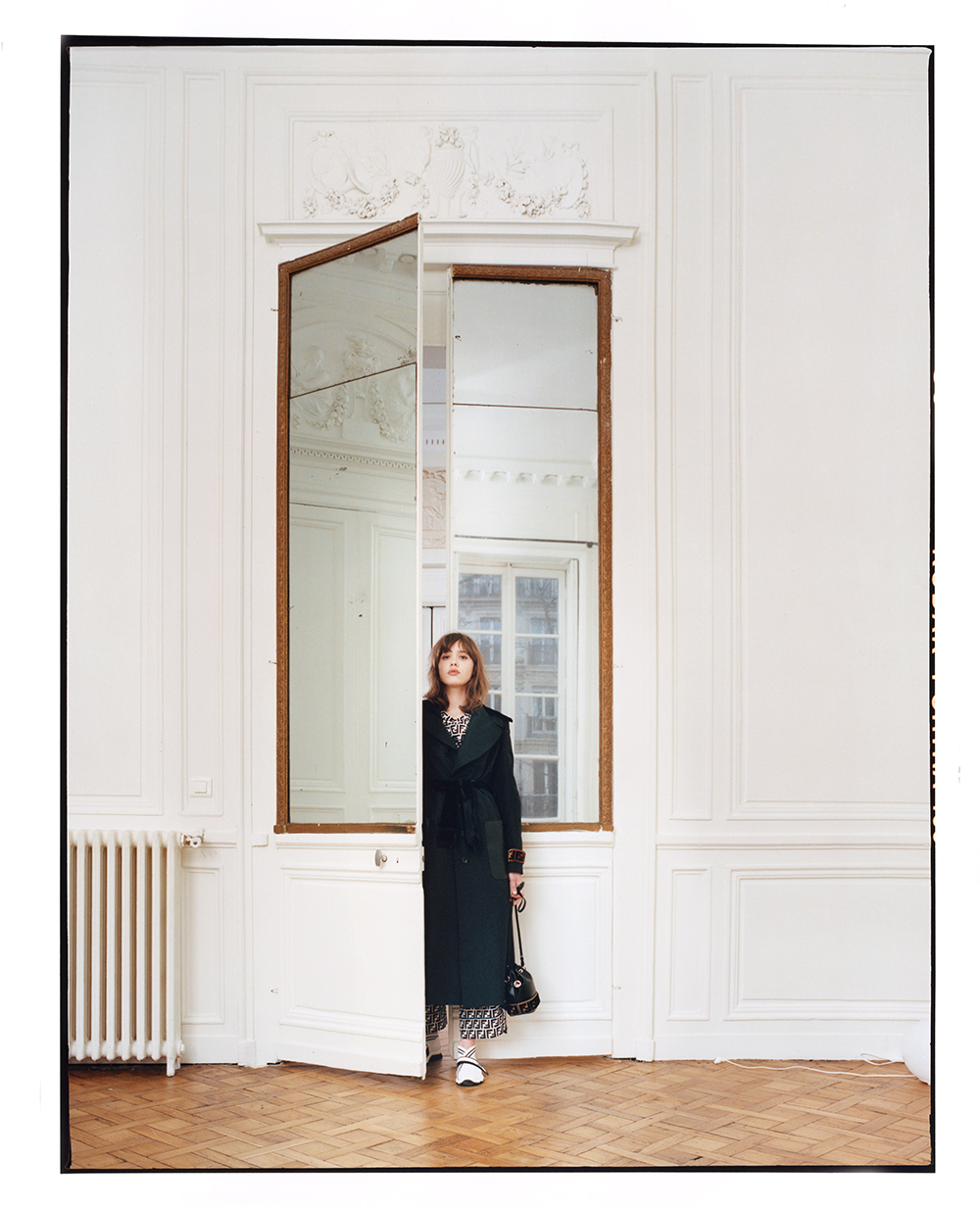
Fendi – FF cotton t-shirt, Wide cotton trousers with FF patterns, Black trench with mink sleeves, Leather and micro-mesh basket and « Mon Trésor » bag in calfskin and fur with FF pattern
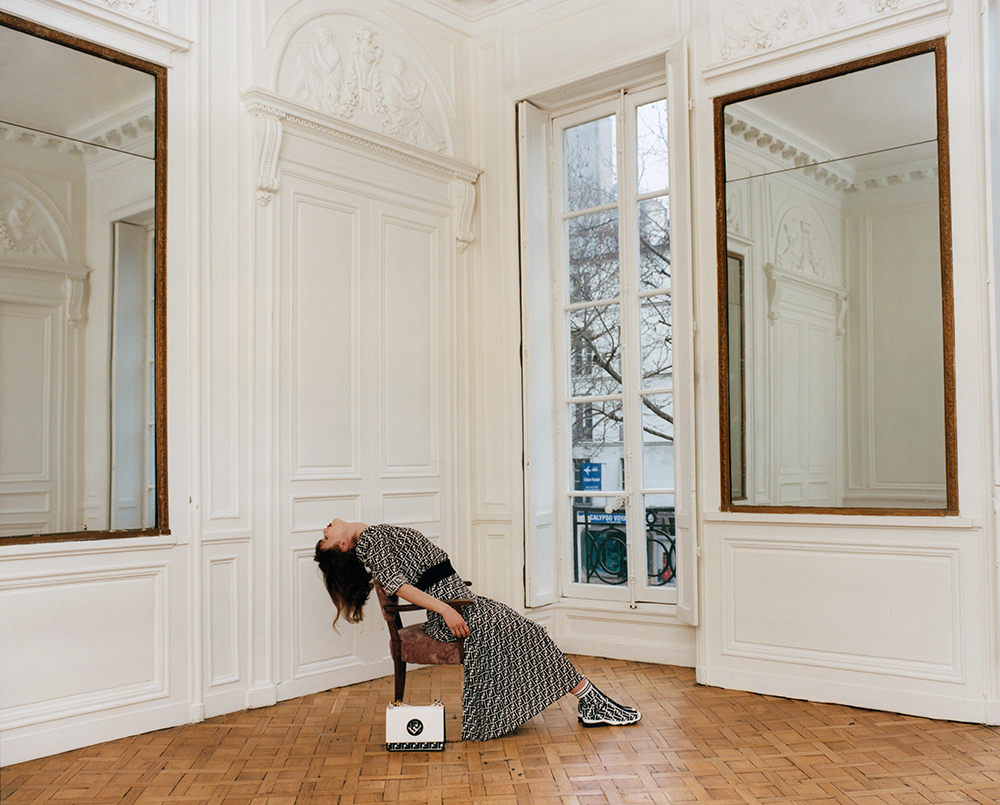
Fendi – Micro-mesh dress with FF pattern, « Kan I » bag in calfskin and velvet FF embroidery and FF micro-mesh trainers
***
Photographer : Karen Paulina Biswell
Stylist : Armelle Leturcq
Make Up and hair: Hugo Villard
Interview: Alice Butterlin






